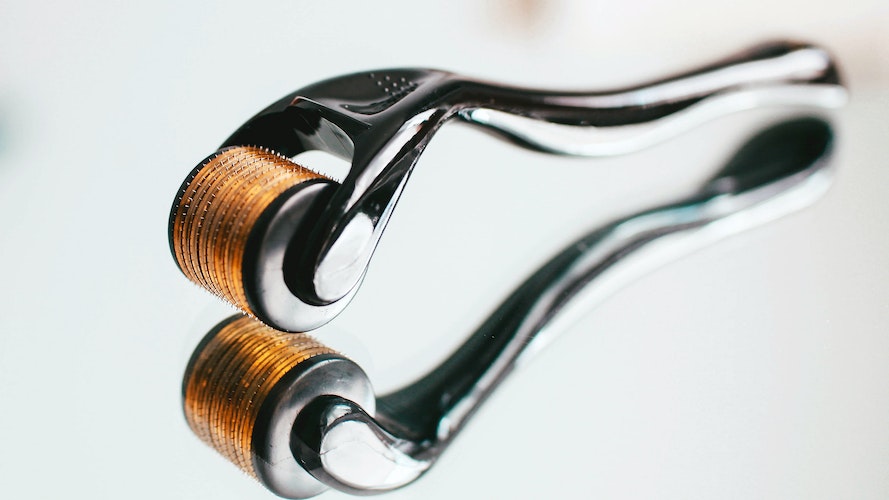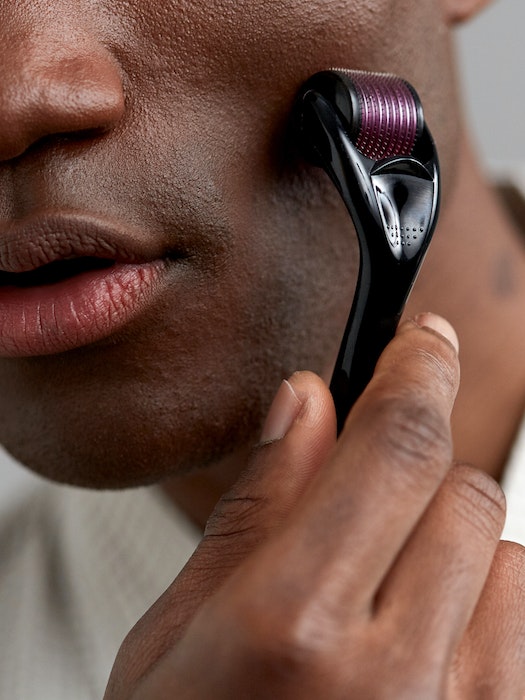Pressing Lightly, Cleaning Carefully & More Tips For Using a Dermaroller at Home
Thespotlyte | August 03, 23

There’s no shortage of at-home versions of professional skincare treatments. If you’re willing to sacrifice speedy results in the name of doing something yourself, you can do everything from lasering away your own hair to microneedling your face. There’s some controversy to the latter, though. Some argue the prickly tool should only be wielded by skilled skincare professionals in sterile rooms; others say there’s no harm in using a device that’s been developed specifically for novice users at home. Here, we break down the difference between getting microneedling done professionally and DIYing it with a dermaroller® — and how to safely use a dermaroller at home. (Hint: you’re pressing too hard!) Keep reading for the scoop from derms and estheticians.
EDITOR’S NOTE
As always, talk to your doctor before starting any new treatment, medication, or supplement.
The Difference Between At-Home and Professional Dermarollers
A dermaroller is a hand-held tool with many microneedles attached to a cylindrical head. It’s called a “roller” because the device is gently pressed and rolled across the skin, which allows the small needles to penetrate the epidermis and create what’s referred to in the biz as “micro injuries.” This is also known as collagen induction therapy.
“The idea behind this is to puncture the skin with tiny injuries, therefore signaling the body to increase collagen and elastin production,” explains Gary Goldfaden, MD, a board-certified dermatologist and founder of his own eponymous skincare line. By stimulating collagen and elastin, which makes the skin look plumper and more even, the dermarolling process results in a reduction of fine lines and wrinkles, dark spots, and even scarring. The tool might also allow for better absorption of ingredients.
While at-home and professional microneedling tools look and handle the same, there’s a key difference: the length of the needles. On average, the length of the needles on an in-office microneedling tool is .5mm to 1.5mm, sometimes reaching 2mm to address scarring. Conversely, the needles on an at-home dermaroller is usually between .25mm and .5mm. “Because the needles are substantially smaller, an at-home dermaroller tool is usually less invasive than a professional tool,” notes Dr. Goldfaden. In other words, using a dermaroller at home versus going to a professional means the tool won’t be as effective. That said, even though an at-home tool can’t cause quite enough intentional damage to reverse deep concerns, it can help products absorb — which can help get you closer to your skincare goals.

What to Know Before Using a Dermaroller at Home
Though you won’t see quite the same benefits as a professional treatment, you still might want to DIY microneedling with a dermaroller. According to skincare experts, there are a few important things to consider if you’re going to indulge in this at-home treatment, with the first being that you can inadvertently overdo it.
“The idea behind dermarollers is that your skin is being injured,” says celebrity esthetician Renee Rouleau. “Injury can actually be a good thing because it sends a signal to tell your skin to stimulate repair, but it’s important to not be hurting your skin all the time.” She notes that your skin needs time to repair and recover itself, and many people don’t give their faces that TLC. Would you do the same weightlifting exercises every single day without letting your muscles recover? No — and similarly, you shouldn’t use your dermaroller every day. The device should only be used one to three times per week.
Furthermore, you should use light pressure — as if you’re delicately running a feather over your skin. Pressing too hard as you roll can cause an injury and lead to an infection (more on this shortly). Easy does it! Listen to your skin and err on the side of under-doing it versus overdoing it. You can roll it back and forth a few times, but the process itself shouldn’t take longer than 10 minutes.
Another key aspect to successful at-home dermarolling is practicing good hygiene. Even those who are hypervigilant about cleanliness (as well as being gentle as they roll!) put themselves at risk for infection. “Not sterilizing a dermaroller properly allows for bacteria and germs to enter the wounded skin,” says Dr. Goldfaden. Additionally, if the needles aren’t clean, then you’re essentially pressing bacteria and gunk into the deeper layers of your epidermis. Infection can lead to ongoing pain and discomfort — and can also result in permanent scarring, the exact opposite of what many people hope to achieve with induction therapy.
To ensure that your dermaroller is clean enough for you to safely use it, you should completely and thoroughly sanitize it after every single use. This means soaking it in 70% isopropyl alcohol for 15 minutes after you’ve finished using it. Also, before using the tool, you must cleanse your skin thoroughly — and that means you should not be applying any serums or treatments before microneedling your face. Instead, slick them on afterwards, and simple hydrating serums and moisturizers are ideal, as they’re least likely to irritate your skin. Avoid comedogenic ingredients like coconut oil, and note that ingredients such as alpha-hydroxy and beta-hydroxy acids and retinol ought to be used sparingly — especially if you have sensitive skin. You also should not apply cosmetics after using a dermaroller, so save this regimen for evenings.
EDITOR’S NOTE
Retinol shouldn’t be used by women who are pregnant, considering getting pregnant, or nursing. Please consult with your doctor before use.
Lastly, it’s important to note that not all people should do at-home dermarolling. Dr. Goldfaden tells us that microneedling is only good for certain skin types (though, for the most part, is a great pick for all skin tones), and ultimately a professional should decide if you’re a good candidate for the treatment. Rouleau agrees, adding that she’s seen many of her patients experience some undesirable side effects, particularly those who are prone to melasma conditions. Better safe than sorry! Consult with your provider to see if at-home microneedling is right for you.
More stories on at-home skincare:






